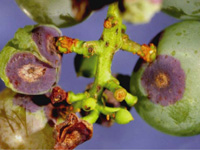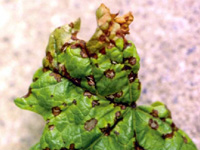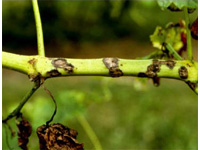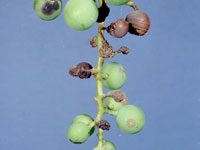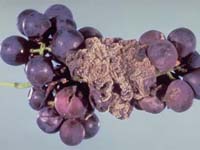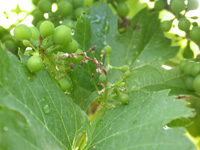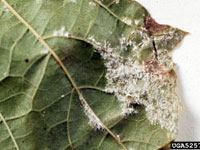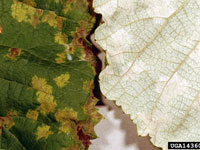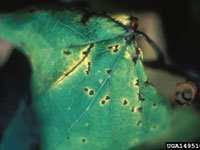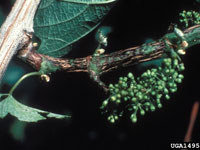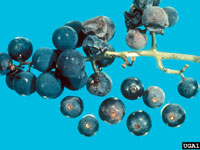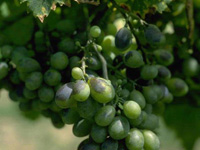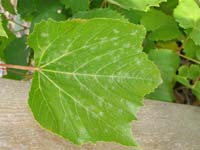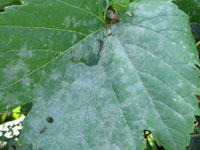Extension > Garden > Diagnose a problem > What's wrong with my plant? > Fruit > Grape > Spotted or discolored fruit
Grape > Fruit > Spotted or discolored fruit
1 of 6
Anthracnose (Bird’s Eye Rot)
Elsinoe ampelina
- Berries develop small, reddish circular spots that average 1/4 inch in diameter that may become sunken with a dark brown to black margin, resembling a “bird’s eye”
- Berries are susceptible from bloom to veraison
- Infected shoots develop spots that become sunken lesions with gray centers and dark reddish-brown raised edges
- Infected shoots may be confused with hail damage; but unlike hail damage, the edges of the lesions are raised and black
- Leaves develop circular lesions with gray centers and brown or black margins, the center of the leaf spot may fall out resulting in small ragged holes in the leaf
- Infection is more prevalent in rainy years
- More information on Anthracnose (Bird’s Eye Rot)
2 of 6
Black Rot
Guignardia bidwellii
- Berries that have been infected for several days dry up, shrink and wrinkle into a bluish black ‘mummy’ that remains attached to the cluster
- A red ring appears on berries, this grows quickly until the entire berry is brown
- Multiple berries in a cluster can be infected
- Symptoms on berries commonly show up when the fruit is half grown
- Leaves have round tan spots with dark edges, tiny black pimples are often visible in the center of the spot
- Black slightly sunken ovals or short streaks can be seen on Infected young green vines, leaf and flower stalks
- More information on Black Rot
3 of 6
Botrytis
Botrytis cinerea
- Berries become soft and watery, and may be covered in a fuzzy white-gray mold
- White grapes will start to turn brown while purple grapes turn reddish in color
- Berries that have been infected for several days will shrivel and drop to the ground as hard mummies
- Multiple berries in a cluster can be infected
- Leaves have large, red-brown patches; a gray mold may or may not be observed on the leaf
- More information on Botrytis
4 of 6
Downy Mildew
Plasmopara viticola
- Infected green fruit turn light brown to purple are soft, covered in a downy felt, and easily fall off the cluster
- Berries are most susceptible when pea-size (early summer) and again when approaching maturity (late summer, early fall)
- Yellow-green “greasy” lesions develop on upper leaf surface
- Lower leaf surface develops a dense, white cottony growth under humid conditions
- More information on Downy Mildew
5 of 6
Phomopsis Cane and Leaf Spot
Phomopsis viticola
- Fruit will turn light brown and shrivel, small raised black pimple like structures may be visible on the fruit surface
- Symptoms on berries are most obvious close to harvest on maturing fruit
- Leaves may be puckered along the veins or the margins may be turned under
- Dark brown spots with yellow edges can also appear along leaf veins and petioles, the lower leaves are most commonly affected
- More information on Phomopsis Cane and Leaf Spot
6 of 6
Powdery Mildew
Uncinula necator
- Berries may be misshapen, covered by the white, powdery growth and often split open
- Infected berries have a rusty spots; red varieties develop a blotchy appearance at harvest
- Upper leaf surface develops white or grayish-white patches
- Can be more prevalent in drier conditions
- More information on Powdery Mildew



